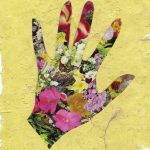Looking into the hand of Lt. Col. Alexander Vindman
We often hear about the power of the mind and associate it to how well a person is capable of using and exerting their mental abilities. Using emotions to control and gain power is often regarded as weak or underhanded. Whereas gaining by using mental or physical strengths is considered admirable. In tarot, I often describe the King of Swords, who is ruled by the element air, as one who uses words as a weapon or words as a tool. For bad or for good. The power of the mind, the intellect. But, what about the power of emotions? Our hands contain several major creases that relate to our strengths and weakness regarding emotions and feelings (heart line), thinking and reasoning (head line), physical energy and vitality (life line), along with motivation and productivity (fate/career line). These are our power tools.
Feelings as a tool.
Feelings as a weapon.
Swearing-ins provide great opportunities to see straight forward close ups of the right hand of prominent people. When I search for close ups of hands I add to the name in the image search the words swear and wave or waving along with the word hand. Here we have a close look at the right palm of Lt. Col. Alexander Vindman, a very accomplished purple heart recipient, who testified at the impeachment hearings led by the Democratic party in the United States House of Representatives recently.
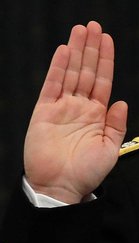
What was noticed during his testimony was his projection of his importance and authority along with a position that he was the person that developed policy and answered to no one when doing so. His lawyer advised him in such a way that he felt he shouldn’t report his insights to his own superior. He implied that he was the one that leaked to the whistle blower whose name was not to be spoken. He also sought to edit the original transcript of the call in question and thought it was his duty to make what he saw as corrections on his own.
What combination of features would come together to describe such a person as this? Interestingly, the most prominent feature is what appears to be a normal heart and head line which is bridged with a crease that forms a type of complete transverse crease, or a Simian Line. When studied as closely as can be with the image found, I would categorize it as a form of the Suwon Crease, which is a sub-category of the Simian.
A dominant characteristic of the creases that transverse the entire palm is that they divide the hand into upper and lower sections. The top of the palm relates to areas that are attributed to feelings, sensations and our emotions. In general this upper area is about how we relate and react to what is happening around and to us. The deeper aspects of our self come from the bottom of the hand where we act on life rather than react and our prompt comes from within ourselves. This latter is often felt as urges and drives and may feel primal or ancestral as well as a calling on our path in life. Some might call that a feeling of our purpose.
In the chart below I have arranged the common forms of the transversal creases into three distinct categories. These are the Suwon (first two rows on left), the Sydney (next two rows) and the Simian (at bottom left of chart). People who have these creases in their palms should be able to match them fairly closely to one or two in the chart, but they may have an even rarer formation that is unique unto themselves.
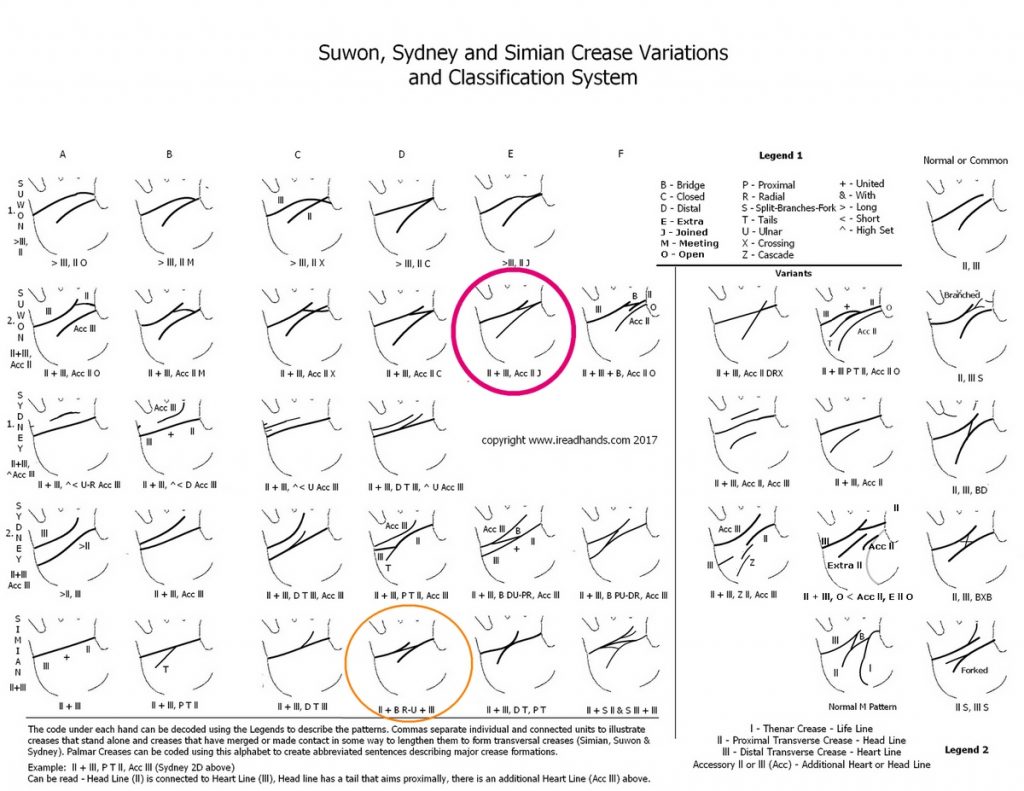
Suwon, Sydney and Simian Chart
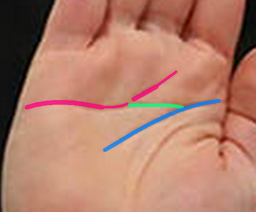
Tracing the lines give us a clearer look into the flow and direction of the creases involved. The pink line is the distal transverse crease aka the heart line. The blue line is the head line also known as the proximal transverse crease. Looking at these two lines as outlined, they appear like normal heart and head lines. The heart line is deeply curved, starting to rise just past under the ring finger and contains a break just as it rises upward. The head line is very high set with its beginning separate from the life line and closer to the base of the index finger than to the thumb. A bridge line that is colored green connects these two major creases. Imagine these combined as tracks with forks in the path that contain gaps and on off switches. The associated energy moves in both directions.
When you compare the creases in Lt. Col. Vindman’s hand to the chart you will find there are two that could apply. My choice for closest match is the one circled in purple. The second choice which might be picked by others is the one circled in orange. A complete transversal crease is formed by the joining together, or meeting in some way, of the heart and head lines. My reasoning behind my choice is that the bridge is meeting the head line on the radial side of the palm. This is related to the Suwon crease which is where there are two distinct head lines and one reaches out to the heart line forming the transversal crease. Here the bridge forms the second head line. The Sydney is associated to the ulnar side of the palm with a piece of heart line meeting the head line. This leaves the medial part of the palm for the Simian crease’s involvement. Some people who study these lines may prefer to associate a bridge only with the Simian regardless of area (ulnar, medial, radial).
These are classifications which label and categorize the crease patterns, changing the category doesn’t change how you’d interpret the essence and influence as the interpretation is based on what you are seeing in front of you and how its own uniqueness tweaks your interpretation. So with that in mind let’s take a closer look at how the combination of features in Lt. Col. Vindman’s hand reflect how he expresses his heart and mind.
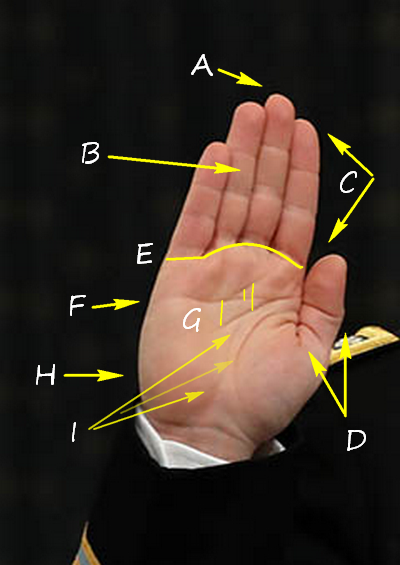
A) At the fingertip level we see a bluntness on most tips with a bit of flaring out of the ring fingertip. The more pointed the tips become, the quicker and easier information flows in and out. Bluntness slows the input and output down for carefulness and control. It adds a closed nature to input. The flared ring fingertip represents an outward expression of personality. The ring finger is often associated with our fire essence in the sense of how we shine, how we perform and present ourselves and our work or what we create. The ring finger is likely to flare at the tip in many of us as it feels good to share with others what we feel we are best at doing. At the same time, this flaring out increases the bluntness and the owner finds it easier to give than to receive. In this hand, being the only flared tip, it shows the area that this person enjoys presentation. Here, only on the ring finger, shows there is a pleasure in performance, to being a center of attention.
All the fingers are held tightly together, and no light comes through all the way down to the base where the fingers meet the palm. There’s an old saying about gaps between the fingers at their base regarding money slipping through the holes in their hands. Here there are no holes, all is well contained. Of course, holding the hand up in a swearing position would add to the intent to hold the fingers together, but closely held fingers add to privacy and secretiveness. In a courtroom environment, this would show a guarded, cautious mood.
B) To add to this sense of privacy, notice the bulging thickness to the middle phalange or section of the fingers. This thickness shows a person that can keep the conversation on others and away from themselves in a long, detailed conversation. The other participant usually doesn’t realize they’ve done most of the sharing and the owner of these fingers carefully listened.
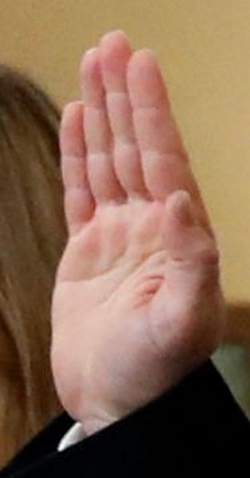
C) Our hand posture can be compared indirectly to our overall physical posture. Notice how straight the stance is of the fingers alongside the index finger down to where the palm meets the thumb. Being able to see a straight vertical line as seen here shows a projection of an inner attitude of confidence. This person holds their head up as they walk looking straight outward rather than downward toward the path in front of them. He appeared in the courtroom wearing his heavily decorated military uniform.
D) Notice how the thumb is held tightly where it meets the palm at the base and also look at how the thumb is bent inwards at the knuckle. Both of these thumb positions are in contrast to the straightly held index finger. The thumb is related to self, ego and outer image while the index finger relates to how we deal with authority and leadership. Two different ways to express taking charge. The long straight index shows a good self esteem and also in combination to details about the index finger it relates to a person’s attitude to following and implementing rules, for rules sake. The thumb brings in the “me” aspect. We could read the submissive body language of the thumb as a kind of insecurity, but the rest of the hand contradicts this perspective. Yet it can’t be overlooked or dismissed. I would read it as indicating his insecurities are overridden by the power of the authority he’s obtained for himself.
E) The cast-off of the fingers from the palm should be a slight curve from little finger across to index finger with the little finger commonly a little lower than the index finger. Variations from this common curve formation show how we have compensated in our life for various weaknesses or strengths by substituting one for the other. This is known as a form of compensatory behavior. Notice here that the little finger is noticeably lower set. This would be another insecurity that is overcome by actions indicated by other digits. Our upbringing can strongly influence the setting of the little finger. Over controlling and a strict requirement for obedience can be one of the causes for a low set little finger. The owners learned early to read body language to know what was expected of themselves. Feelings of a need for outside approval can be one of the results.

F) The heart line during initial development first appears as the crease between the index and middle fingers. As time progresses in the fetal stages the crease forms from the ulnar side of the hand and often these two creases perfectly blend into each other creating a smooth, unbroken, upward curving heart line. Other times the crease, from between the fingers, becomes a part of the Girdle of Venus or continues down into the palm as the fate line. Here there is a tiny space between this crease coming down from the fingers and a major part of the heart line below. Gaps in the heart line can show an ability to stop and control emotions. Heart lines that rise up to the fingers are on warm and affectionate people. Straight heart lines add an intellectual nature to the feelings. Emotions need to make sense. This gap makes the crease between the index and middle fingers more related to the Girdle of Venus than to the heart line. I’d see it as a personal pleasure to being able to feel proud of self or things related to self.
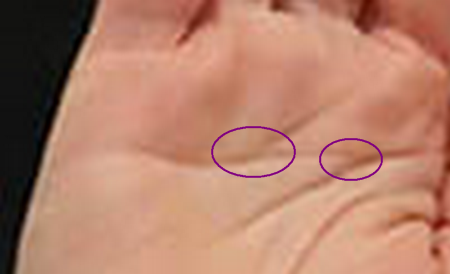
In the image above the gap between the two pieces of heart line is circled. Note that the bridge fades out at both ends without a deep dark colored connection. The place where the bridge meets the head line is also circled. Take a look at how faded the heart line is on the ulnar side of the hand. No color in the marriage line also shows in this zoomed in close up of the palm. A lack of color shows blocked, withheld, or simply a lack of energy in the specific regions. Here we’re looking at bonding and the ability to connect emotionally on a deep level. A lack of color and fading out of the lines indicates this area never developed or has been withdrawn from. I read that Vindman’s mother passed away when he and his identical twin brother were babies and as toddlers immigrated from the Soviet Union with their father. Lt. Col. Vindman began his testimony with heart felt remarks filled with pride to and toward his father. I wonder if this faded out area might also be indicative of the loss of his mother when so very young and affected his ability to bond and surrender on a very deep level. Straight heart lines can show an ability to be emotionally detached or distant.
G) The spacing between the head and heart lines has been referred to as the quadrangle in palmistry. I read it in terms of how open or closed a person is in regards to preferences in life. The difference between narrow and wide is the difference between needing control over choices and environment and being open to compromising and the ability to easily adapt to what is. Here it is interesting that the bridge creates two very different distances. The connecting bridge creates the transverse crease crossing the entire palm. This would allow no space between head and heart line. That’s as narrowly focused as possible with strong preferences. Then we could look at the blue and pink lines without the bridge and see a fairly wide space between them. This would be close to the opposite of narrow. It would add flexibility and acceptance and a willingness to compromise with others. This is where the bridge comes into play and we have different tracks to connect under different circumstances.

A short head line shows quick thinking. When it is high set and separate from the life line it shows a very independent minded, goal oriented person. The tightly curved ‘appearance’ of the heart line shows possessiveness and protectiveness. The gap mentioned above would be an on/off switch as a connected (rising to base of index finger) line here would imply trust of others (add this cautiousness to the blunt fingertips mentioned earlier). The diagonal nature of the head line as seen above relates to a person who aims toward success.
H) The bottom third of the hand is thick and broad while the rest of the hand up to the fingertips is more narrow and long. This thickness adds a brute force physical energy and it also increases the focus of the individual from reacting to life to instead acting from ones own urges and drives. The long narrow upper palm is more intellectual. This is a person who not only intellectualizes everything, but also is ready to take physical action. With a short head line this could be impulsive and quick, yet the longer hand shows someone who spends time thinking and planning. I’d read this as the ability to use knowledge and experience previously gained to make quick decisions and take action in the moment.
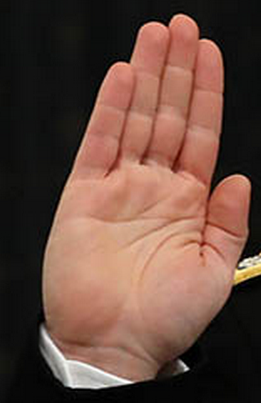
I) This is the last area that I’ll cover here for this particular focus of only one hand as it’s best to be able to compare both hands as some features that are different in the other hand can alter the indications and how a characteristic or trait may be played out.
Here I’ve pointed to the life and fate lines that run close and parallel to each other. If you look closely you can see three curving lines, a deep dark life line, a thinner outer line that proceeds to curve toward the thumb over the life line, and another line that is not as dark or deep as the life line which is the fate line. For such a broad based hand, the life line moves closely to the thumb rather than expanding out toward the center of the palm. This would be indicative of a quiet, introspective personality. The deepest line is the most active and expressive.
Often within the life line is a thick and shorter line that is known as the Inner Mars or Inner Life line. It’s a protective line that adds inner strength and resistance to environmental forces. Interestingly, here it is outside the life line. In this case, I’d see the outer thin line as a kind of facade, a protective outer shield you see before you’re allowed to see the real personality. With the fate line running parallel outside of these two lines there would be a kind of deliberately controlled lock-step behavior in work and life. The fate line does not rise up through the head and heart line features. This person does not want to be told how to think or be supervised.
My summation is that this is a complex person who has a lot of control over how he expresses himself. In many ways he lives with multiple contradictions, yet has blended them into other qualities to make best use of them for his own purposes. When I googled him looking for photos I saw that he is astrologically (Western Astrology) a Gemini, the twins. I mentioned that he has a twin brother. His hand also shows a dual nature. He doesn’t like to be told what to do, yet respects authority; and the stance of the thumb shows something is lacking in the area of self determination and therefore needs approval of others as a motivating factor, but forceful strength shows elsewhere. I would like to see his left hand for comparison to see how alike or different they are to each other.
I referred to the Suwon crease in the title of this post as “Emotional Power”. What I am observing is how more and more of people in positions of power and influence have these Suwon related features. The radial side of the hands relates to initiating factors. Both head line pieces (here the short bridge and the connected head line below), relate to the start of thought. How to begin to manifest an idea. When it connects to the heart, the start is from the mind but from that point on, the emotions are influencing the result. It seems in today’s political environment, we are being influenced heavily by emotions. Words that relate to being emotionally vulnerable such as “snowflake” and “triggered” are commonly heard lately. It appears to me that people who come “from the heart” have risen like cream to the forefront in the current trend of these times.
Unusual creases are mentioned in the palmistry books almost as an aside with more focus on the common features and accompanying personalities. Yet, it seems that these transversal creases are becoming more and more commonly found. They could be seen as people who think and feel “outside the box”. Medical books refer to some of the transversal creases as relating to behavioral problems in childhood, but I often wonder if this is simply trying to fit a square peg into a round hole on the outside of that box.
Update: 10/9/2022

in joy and in gratitude,
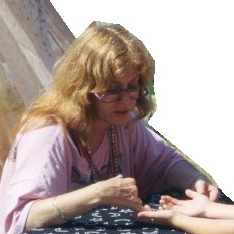
Patti Lightflower
pattilightflower2@gmail.com


